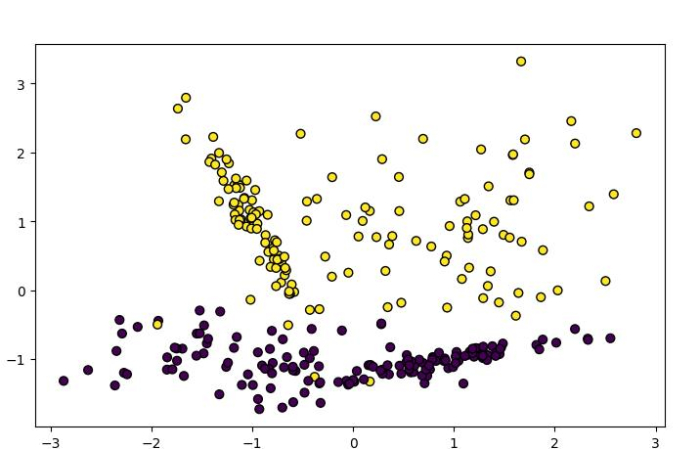Python 如何使用Scikit-learn构建朴素贝叶斯分类器
朴素贝叶斯 分类是基于概率的贝叶斯定理的过程,用于预测未知数据集的类别。Scikit-learn有三个朴素贝叶斯模型,分别是:
- 高斯朴素贝叶斯
- 伯努利朴素贝叶斯
- 多项式朴素贝叶斯
在本教程中,我们将学习使用Python Scikit-learn(Sklearn)构建高斯朴素贝叶斯和伯努利朴素贝叶斯分类器。
高斯朴素贝叶斯分类器
高斯朴素贝叶斯分类器是基于具有均值和方差的连续分布。
通过一个示例,让我们看看如何使用Scikit-Learn Python ML库构建高斯朴素贝叶斯分类器。
对于本例,我们将使用高斯朴素贝叶斯模型,该模型假设每个标签的数据是从简单的高斯分布中绘制的。我们将使用的数据集是乳腺癌威斯康星州诊断数据库。
示例
# Importing the necessary packages
import sklearn
from sklearn.datasets import load_breast_cancer
# Loading the dataset and organizing the data
DataSet = load_breast_cancer()
labelnames = DataSet['target_names']
labels = DataSet['target']
featurenames = DataSet['feature_names']
features = DataSet['data']
# Organizing dataset into training and testing set
# by using train_test_split() function
from sklearn.model_selection import train_test_split
train, test, train_labels, test_labels = train_test_split(features,labels,test_size = 0.30, random_state = 300)
# Model evaluation by using Naïve Bayes algorithm.
from sklearn.naive_bayes import GaussianNB
# Let's initializing the model:
NBclassifier = GaussianNB()
# Train the model:
NBmodel = NBclassifier.fit(train, train_labels)
# Making predictions by using pred() function:
NBpreds = NBclassifier.predict(test)
print("The predictions are:\n", NBpreds[:15])
# Finding accuracy of our Naive Bayes classifier:
from sklearn.metrics import accuracy_score
print("Accuracy of our classifier is:", accuracy_score(test_labels, NBpreds) *100)
输出
它将产生以下输出 –
The predictions are:
[0 0 1 1 0 0 0 1 1 1 1 1 0 1 0]
Accuracy of our classifier is: 93.56725146198829
伯努利朴素贝叶斯分类器
伯努利朴素贝叶斯分类器是一种二元算法。当我们需要检查一个特征是否存在时,它非常有用。
借助一个示例,让我们看看如何使用Scikit-Learn Python机器学习库来构建一个伯努利朴素贝叶斯分类器。
示例
在下面给出的示例中,我们将使用Scikit-Learn Python库在一个虚拟数据集上实现伯努利朴素贝叶斯算法。
from sklearn.datasets import make_classification
# Importing libraries
from sklearn.datasets import make_classification
import matplotlib.pyplot as plt
# Creating the classification dataset with one informative feature and one cluster per class
nb_samples = 300
X, Y = make_classification(n_samples=nb_samples, n_features=2, n_informative=2, n_redundant=0)
# Plotting the dataset
plt.figure(figsize=(7.50, 3.50))
plt.subplots_adjust(bottom=0.05, top=0.9, left=0.05, right=0.95)
plt.subplot(111)
plt.scatter(X[:, 0], X[:, 1], marker="o", c=Y, s=40, edgecolor="k")
plt.show()
输出
我们将得到如下的虚拟数据集 −

示例
现在,让我们在这个虚拟数据集上构建伯努利朴素贝叶斯分类器−
# Importing libraries
from sklearn.datasets import make_classification
import numpy as np
# Model evaluation by using Bernoulli Naïve Bayes algorithm.
# Import Bernoulli Naive bayes from sklearn
from sklearn.naive_bayes import BernoulliNB
# Organizing dataset into training and testing set
# by using train_test_split() function
from sklearn.model_selection import train_test_split
# Creating the classification dataset with one informative feature and one cluster per class
nb_samples = 300
X, Y = make_classification(n_samples=nb_samples, n_features=2, n_informative=2, n_redundant=0)
X_train, X_test, Y_train, Y_test = train_test_split(X, Y, test_size=0.30)
# Let's initializing the model
B_NaiveBayes = BernoulliNB(binarize=0.0)
# Train the model
B_NaiveBayes.fit(X_train, Y_train)
# Making predictions by using pred() function
data = np.array([[0, 0], [0, 1], [1, 0], [1, 1]])
Preds=B_NaiveBayes.predict(data)
print(Preds)
输出
它将产生以下输出:
array([0, 0, 1, 1])
 极客笔记
极客笔记